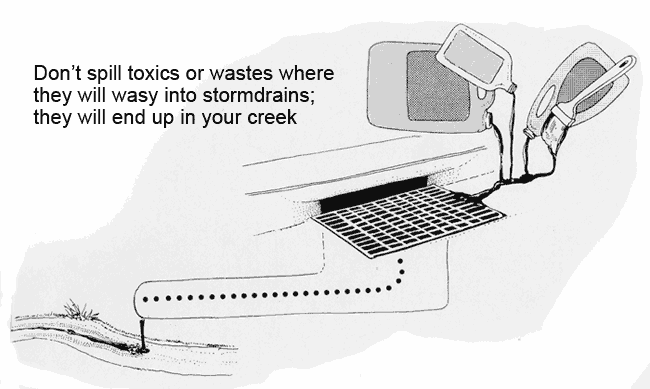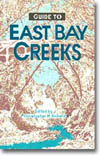GUIDE TO EAST BAY CREEKS
Chapter Eight
Do's & Don'ts
|
Important do's and don'ts:
-
Do have fun! Get to know your neighborhood creek so you can appreciate it and understand when a significant change has occurred.
-
Do form a community group to restore and preserve your neighborhood creek.
-
Do organize creek cleanups and make sure your creek is kept free of debris. It's especially important to remove debris in the spring and fall and before major storms.
-
Don't dump wastes down storm drains. These feed directly into creeks and eventually into the Bay. Water quality and wildlife could be seriously damaged.
-
Do report chemical or petroleum spills or illegal dumping first to 911, then to U.S. Coast Guard Marine Safety Office, (510) 437-3800; Bay Keeper, 800 533-7229; and Regional Water Quality Control Board (510) 286-1255. Government agencies are understaffed and need your help to monitor abuses.
-
Do recycle used motor oil and anti-freeze. Dumping one quart of motor oil can contaminate 250,000 gallons of water.
-
Do take unwanted household hazardous materials and containers to a local collection program for disposal.
-
Do use kitty litter or other absorbent material to clean spills from paved surfaces.
-
Do conserve water when washing your car, and use biodegradable soap.
-
Don't dump trash into creeks. It pollutes the creek and looks ugly. Piles of tires, shopping carts, and furniture can cause destructive flooding and erosion.
-
Don't dump grass clippings and yard debris into creeks; they overload creeks with nutrients and absorb oxygen. Dumping also introduces alien plant species into the streamside plant community.
-
Do landscape with native vegetation. It provides good habitat and requires less water, pesticides, and herbicides.
-
Do avoid the use of herbicides, pesticides, and fertilizers. Irrigation and rainwater carry them into the creeks and the Bay.
-
Do use a broom to clean up garden clippings rather than hosing down debris.
-
Do minimize pet and livestock access to streams and riparian areas.
-
Do check for soil erosion on your property and in your neighborhood. Halt erosion promptly.
-
Do control erosion at construction sites and prevent dirt and debris from entering storm drains or creeks.

Chapter 7 Chapter 9
Top of PageTable of ContentsGlossary |
 There are many actions that urban residents can take to protect their creeks, both by doing certain things and by not doing others.
One of the most important things to understand is that urban runoff brings pollutants into creeks and ultimately into San Francisco Bay. Storm drains are not sewers; the water in storm drain receives no treatment before
being dumped into creeks or the Bay. What is spilled on the ground ends up in the Bay.
There are many actions that urban residents can take to protect their creeks, both by doing certain things and by not doing others.
One of the most important things to understand is that urban runoff brings pollutants into creeks and ultimately into San Francisco Bay. Storm drains are not sewers; the water in storm drain receives no treatment before
being dumped into creeks or the Bay. What is spilled on the ground ends up in the Bay.